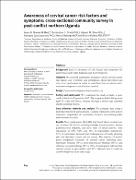| dc.contributor.author | Mwaka, Amos Deogratius | |
| dc.contributor.author | Orach, G. Christopher | |
| dc.contributor.author | Were, M. Edward | |
| dc.contributor.author | Lyratzopoulos, Georgios | |
| dc.contributor.author | Wabinga, Henry | |
| dc.contributor.author | Roland, Martin | |
| dc.date.accessioned | 2021-04-28T11:21:08Z | |
| dc.date.available | 2021-04-28T11:21:08Z | |
| dc.date.issued | 2015-06-11 | |
| dc.identifier.citation | Mwaka, A.D., Orach, C.G., Were, E.M., Lyratzopoulos, G., Wabinga, H. and Roland, M., 2016. Awareness of cervical cancer risk factors and symptoms: cross‐sectional community survey in post‐conflict northern Uganda. Health Expectations, 19(4), pp.854-867. | en_US |
| dc.identifier.issn | 1369-7625 | |
| dc.identifier.uri | http://hdl.handle.net/20.500.12280/2769 | |
| dc.description.abstract | Background Lack of awareness of risk factors and symptoms for cancer may lead to late diagnosis and poor prognosis.
Objective We assessed community awareness about cervical cancer risk factors and symptoms and perceptions about prevention and cure of cervical cancer in order to contribute data to inform inter ventions to improve cervical cancer survival.
Design Cross-sectional population-based survey. Setting and participants We conducted this study in Gulu, a post-conflict district in Uganda in 2012. The sample included 448 persons aged 18 years and above, selected through a multi-stage stratified
cluster sampling process. Data collection methods and analysis We collected data using a pretested structured questionnaire. Logistic regressions were used to determine magnitudes of associations between socio-demographic
and outcome variables.
Results Most participants (444/448) had heard about cervical cancer. Known risk factors including multiple sexual partners, human papillomavirus infection, and early onset of sexual activity, were recognized by 88%, 82%, and 78% of respondents respectively. 63% of participants believed that prolonged use of family planning pills and injections caused cervical cancer. The majority of participants recognized symptoms of cervical cancer including inter-menstrual bleeding (85%), post-menopausal bleeding (84%), and offensive vaginal discharge (83%). 70% of participants believed that cervical cancer is preventable and 92% believed that it could be cured if diagnosed at an early stage. | en_US |
| dc.language.iso | en | en_US |
| dc.publisher | John Wiley & Sons, Inc. | en_US |
| dc.relation.ispartofseries | Health Expectations;19(4) | |
| dc.subject | Awareness | en_US |
| dc.subject | Cervical cancer | en_US |
| dc.subject | Health seeking | en_US |
| dc.subject | Perceived causes | en_US |
| dc.subject | Post-conflict northern Uganda | en_US |
| dc.subject | Risk factors | en_US |
| dc.title | Awareness of Cervical Cancer Risk Factors and Symptoms: Cross-Sectional Community Survey in Post-Conflict Northern Uganda | en_US |
| dc.type | Article | en_US |


